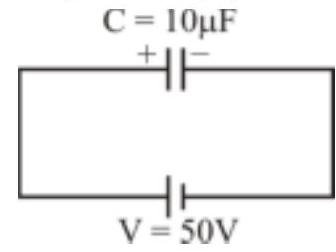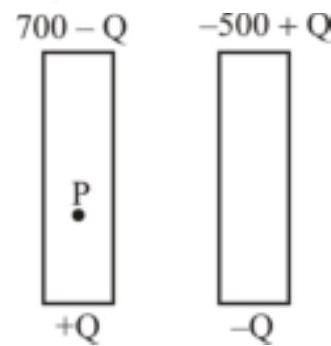165589 The distance between two plates of a capacitor is $d$ and its capacitance is $C_{1}$, when air is the medium between the plates. If a metal sheet of thickness $\frac{2 d}{3}$ and of same area as plate is introduced between the plates, the capacitance of the capacitor becomes $C_{2}$. The ratio $\frac{C_{2}}{C_{1}}$ is:
165596 A capacitor of capacitance $10 \mu \mathrm{F}$ is charged to potential $50 \mathrm{~V}$ with a battery. The battery is now disconnected and an additional charge $200 \mu \mathrm{C}$ is given to the positive plate of the capacitor. The potential difference across the capacitor will be
165589 The distance between two plates of a capacitor is $d$ and its capacitance is $C_{1}$, when air is the medium between the plates. If a metal sheet of thickness $\frac{2 d}{3}$ and of same area as plate is introduced between the plates, the capacitance of the capacitor becomes $C_{2}$. The ratio $\frac{C_{2}}{C_{1}}$ is:
165596 A capacitor of capacitance $10 \mu \mathrm{F}$ is charged to potential $50 \mathrm{~V}$ with a battery. The battery is now disconnected and an additional charge $200 \mu \mathrm{C}$ is given to the positive plate of the capacitor. The potential difference across the capacitor will be
165589 The distance between two plates of a capacitor is $d$ and its capacitance is $C_{1}$, when air is the medium between the plates. If a metal sheet of thickness $\frac{2 d}{3}$ and of same area as plate is introduced between the plates, the capacitance of the capacitor becomes $C_{2}$. The ratio $\frac{C_{2}}{C_{1}}$ is:
165596 A capacitor of capacitance $10 \mu \mathrm{F}$ is charged to potential $50 \mathrm{~V}$ with a battery. The battery is now disconnected and an additional charge $200 \mu \mathrm{C}$ is given to the positive plate of the capacitor. The potential difference across the capacitor will be
165589 The distance between two plates of a capacitor is $d$ and its capacitance is $C_{1}$, when air is the medium between the plates. If a metal sheet of thickness $\frac{2 d}{3}$ and of same area as plate is introduced between the plates, the capacitance of the capacitor becomes $C_{2}$. The ratio $\frac{C_{2}}{C_{1}}$ is:
165596 A capacitor of capacitance $10 \mu \mathrm{F}$ is charged to potential $50 \mathrm{~V}$ with a battery. The battery is now disconnected and an additional charge $200 \mu \mathrm{C}$ is given to the positive plate of the capacitor. The potential difference across the capacitor will be
165589 The distance between two plates of a capacitor is $d$ and its capacitance is $C_{1}$, when air is the medium between the plates. If a metal sheet of thickness $\frac{2 d}{3}$ and of same area as plate is introduced between the plates, the capacitance of the capacitor becomes $C_{2}$. The ratio $\frac{C_{2}}{C_{1}}$ is:
165596 A capacitor of capacitance $10 \mu \mathrm{F}$ is charged to potential $50 \mathrm{~V}$ with a battery. The battery is now disconnected and an additional charge $200 \mu \mathrm{C}$ is given to the positive plate of the capacitor. The potential difference across the capacitor will be



